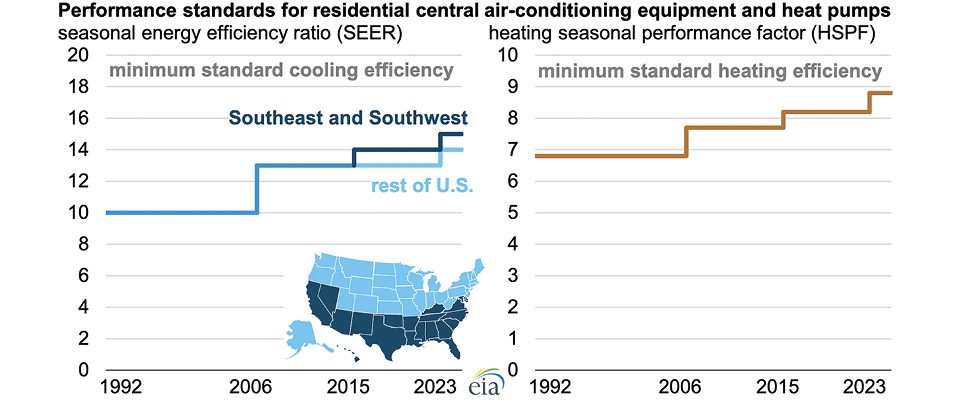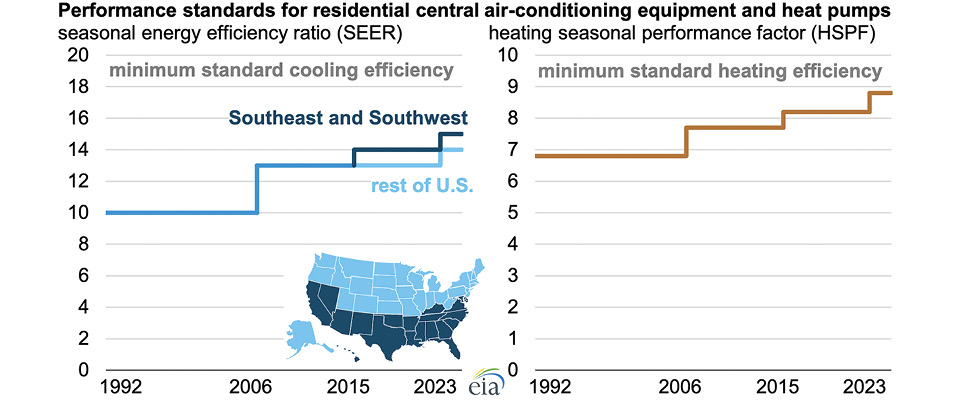
The era of heat pumps is here, and the federal government is hoping to accelerate the use of this heating, ventilation and air conditioning (HVAC) technology in order to drastically reduce energy usage and greenhouse gas emissions.
To encourage development and adoption of heat pumps, the United States Department of Energy (DOE) is focusing on incentives specifically for commercial rooftop units (RTUs). The DOE estimates that heat pump RTUs reduce greenhouse gas emissions and energy costs by up to 50% compared to conventional natural gas heating.
This past spring, the DOE launched a program called the Better Buildings Commercial Building Heat Pump Accelerator to work with stakeholders, from commercial building owners and operators to manufacturers. The purpose is to speed up the development and adoption of heat pump packaged RTUs to achieve integrated energy efficiency and electrification of buildings.
A heat pump functions like a combined central air conditioner and furnace. Because it absorbs and moves ambient heat rather than burning fuel or electricity to generate it, heat pumps are exceptionally energy efficient and environmentally friendly compared to other heating and cooling options.
Much of the efficiency of RTUs depends on the electric motors that are installed by the manufacturer. Many heat pumps feature variable-speed ECM motors on their indoor fans (blowers), outdoor fans, or both. The variable-speed controls for these fans are designed to move the air based upon demand at a comfortable velocity, minimizing drafts and maximizing energy savings. Going forward, we expect ECMs to be the standard due to their significant energy savings potential.
About the DOE Program
The Commercial Building Heat Pump Accelerator is part of the DOE’s Better Buildings, Better Plants Initiative, which seeks to reduce the greenhouse gas emissions associated with heating and cooling large commercial buildings. To date, the initiative has attracted more than 900 partners who have saved more than 3.1 quadrillion British thermal units (BTUs) of energy. The DOE states that the savings resulted in $18.5 billion in energy costs.
In a press release, U.S. Secretary of Energy Jennifer M. Granholm stated: “Congress requires DOE to issue energy efficiency standards for a range of appliances, and we have successfully met this mandate through robust collaboration between industry, manufacturers and consumer groups.”
Impact in the Industry
While the impact of this program on the environment could be considerable, how will it affect those of us in the industry?
First, starting in 2023, the Residential Federal Minimum Standards changed based on geographic location where required seasonal energy efficiency ratio (SEER) ratings increased by one point.

Minimum SEER Requirements for Residential Air Conditioning & Heat Pumps
As mentioned, this rule was enacted in 2023. Now, the commercial market for heat pumps is where all the current activity is at the DOE. The Commercial Building Heat Pump Accelerator is having a significant impact on heat pump manufacturers. Here’s how:
- Increased efficiency standards: The initiative is pushing manufacturers to develop higher-efficiency heat pump RTUs. These new RTUs are expected to reduce greenhouse gas emissions and energy costs by up to 50% compared to conventional units.
- Collaboration and innovation: The Accelerator is fostering collaboration between manufacturers, commercial building owners and operators. This partnership aims to accelerate the development and adoption of next generation heat pump technologies.
- Market expansion: By promoting the adoption of more efficient heat pump technologies, the initiative is expanding the market for these products.
- Economic benefits: If these advanced RTU heat pumps are deployed at scale, they could save American businesses and commercial entities as much as $5 billion annually on utility bills.
- Regulatory support: The DOE’s involvement provides a regulatory framework that supports the development and deployment of the technologies, ensuring that they meet stringent energy efficiency and performance standards.
Overall, the Commercial Building Heat Pump Accelerator is driving innovation, collaboration and market growth in the heat pump industry, benefiting both manufacturers and consumers.
The initiative aims to bring more efficient, next-generation heat pump RTUs to market by 2027. This timeline reflects the collaborative efforts between the DOE, manufacturers and commercial building stakeholders to accelerate the development and adoption of these high-efficiency technologies.
How to Get Involved
Commercial buildings and engineering service firms can participate in the Commercial Building Heat Pump Accelerator by joining the initiative’s campaign. Here are the steps to
get involved:
- Fill out the partnership agreement form. Interested organizations need to complete this form, which is available on the Better Buildings Solution Center website: betterbuildingssolutioncenter.energy.gov.
- Send the completed form to betterbuildings@ee.doe.gov.
- Schedule a discussion. After your form is submitted, the campaign team will reach out to schedule a discussion with your organization to discuss participation details and any pertinent next steps.
Once your organization becomes part of the initiative, the program states you will receive resources and guidance to deploy heat pump technology, including:
- Decision trees and guidance documents for site-level and portfolio-level evaluations
- Estimates on energy, economic and emissions comparisons for different regions of the country
- Case studies showing successful implementations of heat pump RTUs
- Peer-to-peer learning through working groups.
By joining the campaign, commercial buildings can access technical assistance and support to achieve their energy efficiency and decarbonization efforts.
Industry contractors should also stay updated on the latest technologies and installation practices as the DOE states these changes will likely lead to increased demand for training and new certification programs. With the push for more efficient heat pump RTUs, contractors will see new business opportunities in retrofitting existing systems and installing new, high-efficiency units. Contractors will also need to be aware of and comply with new local, state and federal regulations led by or set by the DOE for heat pump RTUs.

